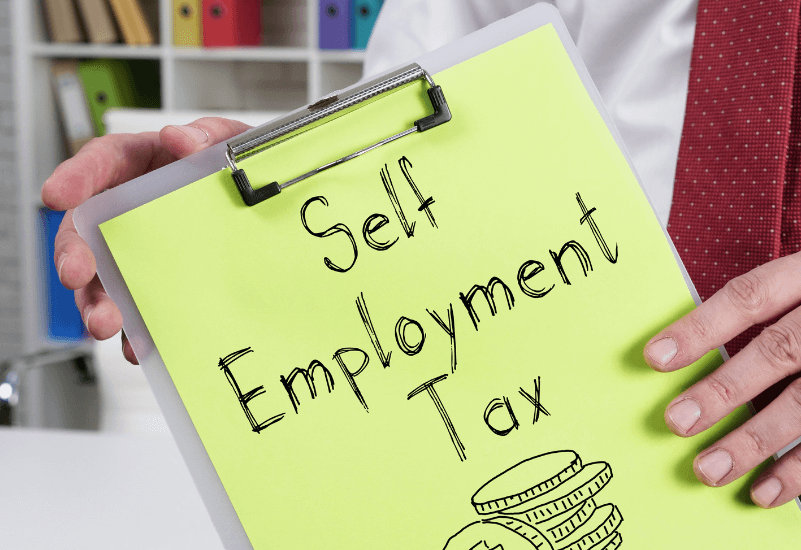- February 6, 2024
- Posted by: Gavtax
- Category: U.S. Taxes - Individual

Are you one of the 10% of Americans forging their own path through self-employment?
In this video, we’ll simplify the maze of self-employment taxes, ensuring you’re well-informed and prepared. Let’s get started!
1. What are self employment taxes?:
Self-employment taxes are taxes that individuals who work for themselves pay to the government. These taxes are mainly for Social Security and Medicare, which are programs that provide benefits for retirees, the disabled, and children. When you’re self-employed, you’re both the employer and the employee.
This is different from wage earners, who work for a company where the employer pays half of these taxes and the employee pays the other half. In self-employment, you’re responsible for the whole amount, which is why understanding these taxes is essential for anyone running their own business.
2.Self-Employment Tax Rate:
The Self-Employment Tax rate is a critical aspect for anyone working for themselves. Here’s a simple breakdown:
- Total Tax Rate: The total self-employment tax rate is 15.3%. This might seem high, but it’s because you’re paying both the employer and employee portions.
- Social Security: 12.4% of this rate goes towards Social Security, which is a system that helps with benefits for retirees, people with disabilities, and dependents.
- Medicare: The remaining 2.9% is for Medicare, which is health insurance for people aged 65 and over, as well as for some younger people with disabilities.
Therefore, the 15.3% = 12.4% for Social Security + 2.9% for Medicare taxes.
2.Income Limits and Calculations:
-
- Not all your income is taxed at 15.3%:Only your net earnings from self-employment, which means your business income minus your business expenses.
- For Social Security: only the first $137,700 of your net earnings (as of 2020) is taxed at 12.4%. Income above this limit isn’t subject to the Social Security part of the tax.
- For Medicare: all your net earnings are subject to the 2.9% tax. There’s no upper limit like there is for Social Security.
3.Additional Medicare Tax:
The Additional Medicare Tax is an another type of tax for self-employed individuals:
1.Extra Tax Rate: This tax adds an additional 0.9% to the standard Medicare tax. It applies only when your income goes above certain levels.
2.Income Thresholds Based on Filing Status:
-
- Single Filers: If you file your taxes as a single person, this extra tax starts once your income goes over $200,000.
- Married Filing Jointly: For couples who file their taxes together, the threshold is $250,000.
- Married Filing Separately: If you’re married but file separately, the limit is lower, at $125,000.
It’s important l to remember these limits as they determine when the additional tax kicks in. Remember, this is only for Medicare and is separate from the standard 2.9% Medicare tax that applies to all your net earnings.
4.Deductions Related to Self-Employment Tax:
Deductions related to self-employment tax can significantly reduce your taxable income:
1.Employer-Equivalent Portion Deduction:
-
- Half of your self-employment tax can be deducted from your adjusted gross income.
- This mirrors the employer’s share in a traditional employment setting and lowers your taxable income.
5.Eligibility for Paying Self-Employment Tax:
Understanding who must pay self employment tax is essential for anyone working independently:
1.General Rule for Self-Employed Individuals:
-
-
- If your net earnings from self-employment are $400 or more in a year, you need to pay self-employment tax.
- Net earnings mean your total earnings after deducting business expenses.
-
2.Church Employees:
-
-
- Special rules apply to church employees. If you earn $108.28 or more from church-related activities, you might need to pay self-employment tax, even if you’re not considered self-employed in other contexts.
-
3.Caregivers:
-
-
- Caregivers, like nannies or home health aides, often fall into the self-employed category. If you provide caregiving services and meet the earnings threshold, you’re likely subject to self-employment tax.
-
4.Importance of Accurate Classification:
-
- It’s to correctly determine if you’re self-employed. Replace the word crucial with something else, it appears too often. This affects not only your tax obligations but also your eligibility for certain deductions and credits.
6.Procedure for Paying Self-Employment Tax:
Paying self-employment tax involves a straightforward process:
1. Identification Requirements:
-
-
- You need a Social Security Number (SSN) or an Individual Taxpayer Identification Number (ITIN) to pay taxes.
-
2. Paying Through Estimated Taxes:
-
- Since self-employment income doesn’t have taxes withheld like a regular salary, you need to pay estimated taxes quarterly.
- Estimated taxes include both income tax and self-employment tax.
- You calculate these based on your expected income, deductions, and credits for the year.
Understanding and following these steps ensures that you stay compliant with tax regulations as a self-employed individual.
As we wrap up our video on self-employment taxes, remember the key points we’ve covered: understanding your tax rate, knowing when additional taxes apply, leveraging deductions, and following the correct payment procedures.
If you found this information helpful, please consider subscribing for more insightful content. Don’t forget to consult a tax professional for personalized advice. Thanks for watching, and stay tuned for more useful tips and guides!
